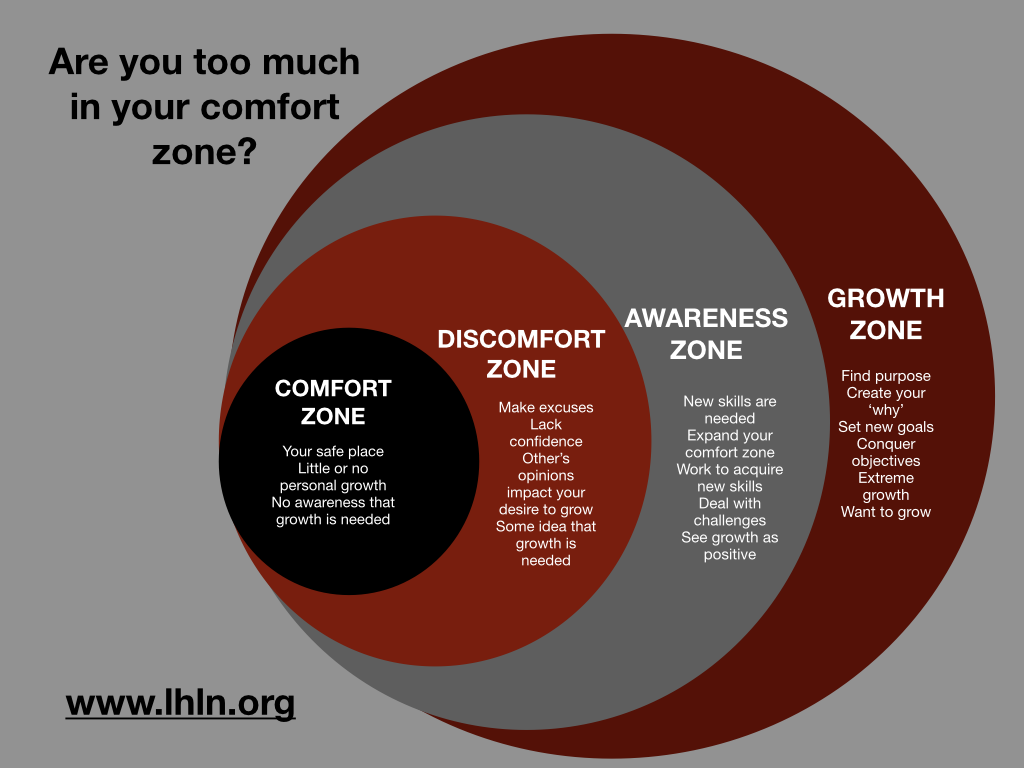Getting in the Zone
May 24, 2022
“Do one thing every day that scares you.”
Eleanor Roosevelt
At LHLN, our team talks a lot about the “comfort zone”. Not only do we talk internally about challenging ourselves and each of our staff members to step outside their comfort zone, but we also encourage our audience to grow their leadership by stepping out of their comfort zone. In fact, this week’s podcast focuses on the “comfort zone”. Specifically, the fact that every single one of us find it difficult to step outside of our personal comfort zone. Much has been written and said about the importance of pushing out of your comfort zone by others. Since starting our podcast 3 years ago, I have dedicated 4 podcast episodes to the importance as a leader of pushing yourself OUT of your comfort zone (see episodes 24, 25, 26, and 124).
But today, I want to take a deeper dive into this topic and talk about what I see as the 4 zones of growth. I originally introduced this concept in podcast episode 25 and 26 where I discussed why each is zone important and what each one does for us as human beings.

In the diagram above, there are 4 circles. The smallest and furthest left is the COMFORT ZONE; better known as your “safe place”. Our primal brain likes it here, because it’s predictable and there are no threats. It’s a place to chill out and zone out. For most of us, that physical place is our residence or a specific chair, room, location, etc. in the place we call home. But it’s also a state of being. Our COMFORT ZONE is where we feel safe making decisions and living our lives.
From time to time, our COMFORT ZONE, is an important place for us to recharge. We all need a safe place to decompress and destress. But, where one is “safe,” one is not challenged to grow. As leaders and individuals, this is a dangerous place to stay in for any extended period of time. In fact, as leaders, we must seek outgrowth and, in doing so, must push ourselves into the discomfort, awareness, and growth zones. Sometimes this occurs gradually and other times it’s a leap straight to the GROWTH ZONE depending on the perceived need for growth.
We often don’t realize that we need to grow until an external event pushes us into what I call the DISCOMFORT ZONE. Maybe it was a comment from a spouse or a colleague that made us realize that we aren’t as “perfect” or “prepared” as we thought. That opinion of another or desire to compete with another person propels us into the next layer which is the AWARENESS ZONE.
In the AWARENESS ZONE, we realize that we need to grow in a particular area and we begin to seek information. Maybe it’s weight loss and/or a desire to get healthy. You start researching what might work for your lifestyle and how you can start to change habits that have led to your current state. You acquire the skills needed to achieve your specific goals and set the intention of developing them – you begin to see growth as a positive thing and continue pushing further to the GROWTH ZONE.
In the GROWTH ZONE, you develop your “why” for wanting to grow in the area identified. You find purpose and schedule it into your daily routine to make sure you acquire what is needed to achieve the desired outcome. As you achieve your initial goals, you see growth as a positive and set more and more goals. This is where true growth occurs.
What’s NOT on this diagram, is the PANIC ZONE, but make no mistake, it is a real thing. Just as you not wanting to stay too long in your COMFORT ZONE, it’s equally important to avoid being pushed into the PANIC ZONE. When you are pushed into your PANIC ZONE, you usually become REACTIVE rather than RESPONSIVE to the needed growth and you tend to see growth as a threat and not an opportunity. When you land in your PANIC ZONE, your primal brain kicks in and starts reacting to every single thing as a threat to your safety. This creates extreme stress and often leads to bad decisions and/or actions. You cannot always avoid it, but it’s best to recognize the physical, mental, and emotional symptoms of your own personal PANIC ZONE. In doing so, you can develop techniques that actually calm the brain back to a position of reasonableness that enables you to set realistic growth goals.
In summary, the goal is to find yourself constantly striving to be in the GROWTH ZONE. Just outside of your COMFORT ZONE enough to challenge yourself and to be responsive, but not so far out that you enter your PANIC ZONE and become reactive. When you push for the GROWTH ZONE, you find yourself pushing it further and further out and actually reducing the circumstances that lead to your PANIC ZONE, because you have worked to develop the skills and abilities needed to focus on growth.
Remember these two quotes, “A comfort zone is a beautiful place, but nothing ever grows there” by John Assaraf and “It’s only after you’ve stepped out of your comfort zone that you begin to change, grow, and transform” by Roy T. Bennett from The Light of the Heart.
Dean
Stay connected with news and updates!
Join our email list to receive the latest news and updates from the LHLN team!
We will never sell your information, for any reason.
